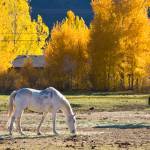Fatal Horse Malady Linked to Pasture Trees

Consumption of box elder tree seeds by horses has been identified as the cause of seasonal pasture myopathy, according to research conducted at the University of Minnesota. Box elder trees are a member of the maple family, and several other trees in the genus Acer have qualities that make consumption of leaves harmful to horses.
Horses with seasonal pasture myopathy show signs such as stiff gaits, incoordination, rapid breathing, passing of dark-colored urine, and eventual recumbency. The malady, which is seen most often in the fall, is fatal in between 75 and 95 percent of affected horses.
Seeds of the box elder contain hypoglycin A, a toxin that has been recovered in the urine and blood of horses with seasonal pasture myopathy. The toxin works on muscle fibers by blocking fat metabolism, affecting the action of the muscles that support posture and respiration. Cardiac muscle fibers can also be affected.
Box elder trees are found in northern Europe, where seasonal pasture myopathy has also been reported. Though the tree is not a native species in North America, it is widespread in Canada and the eastern half of the United States. Horses don’t normally eat the seeds, though those turned out on sparse fall pasture may consume seeds as well as other plant parts that are usually avoided.
Some horses share a pasture with box elder trees for years and never develop any signs of seasonal pasture myopathy. This might indicate that those horses avoid eating the seeds or that the particular trees in those pastures have seeds with lower levels of toxic chemicals than trees in other locations. To minimize risk, property owners can offer hay as an extra forage source when horses are turned out on overgrazed pastures. Limiting pasture access to 12 hours a day in fall months or during drought conditions is also suggested.
Owners of horses with access to box elder seeds should be vigilant for any signs consistent with seasonal pasture myopathy, and should contact a veterinarian as soon as signs are noticed. Early diagnosis and treatment are important in giving affected horses the best chance to survive the disease.
In order to continue collecting data, researchers at the University of Minnesota are asking owners with horses that have had this problem, or are experiencing signs, to contact a local veterinarian for immediate care and then complete a risk assessment survey. Owners will be contacted by a university veterinarian to discuss the possibility of blood testing to assess hypoglycin A toxicity.








